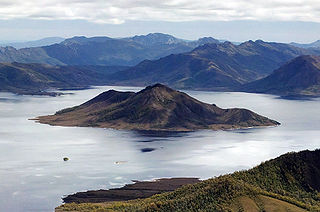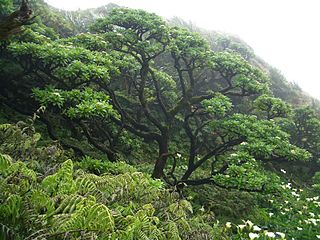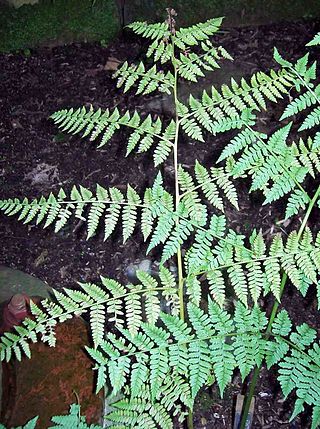
The Tasmanian temperate rain forests are a temperate broadleaf and mixed forests ecoregion in western Tasmania. The ecoregion is part of the Australasian realm, which includes Tasmania and Australia, New Zealand, New Guinea, New Caledonia, and adjacent islands.

The flora of Saint Helena, an isolated island in the South Atlantic Ocean, is exceptional in its high level of endemism and the severe threats facing the survival of the flora. In phytogeography, it is in the phytochorion St. Helena and Ascension Region of the African Subkingdom, in the Paleotropical Kingdom.

Pteridomania or fern fever was a Victorian craze for ferns. Decorative arts of the period presented the fern motif in pottery, glass, metal, textiles, wood, printed paper, and sculpture, with ferns "appearing on everything from christening presents to gravestones and memorials".
This is a list of the flora of the Tubuai, an island in French Polynesia.

Diplazium australe, commonly known as the Austral lady fern, is a small fern occurring in eastern Australia, New Zealand and Norfolk Island. The habitat is moist shaded areas, often occurring in rainforest.
Victoria, Australia contains approximately 32,000 hectares of temperate rainforest in various regions, which represents 0.14% of the State's total area. The areas with rainforest include: East Gippsland, Strzelecki Ranges, Wilsons Promontory, Central Highlands, and Otway Ranges. The rainforests vary between cool temperate, warm temperate, and mixed cool temperate.
Gopinath Panigrahi is a botanist and plant taxonomist. He was born in the village Baikunthapur, Basudebpur block, Bhadrak district, Orissa, India and obtained a Ph.D. in 1954 from the University of Leeds where he studied Cytogenetics.

The Tubuai tropical moist forests is a tropical and subtropical moist broadleaf forests ecoregion in French Polynesia. It covers the Austral Islands.






